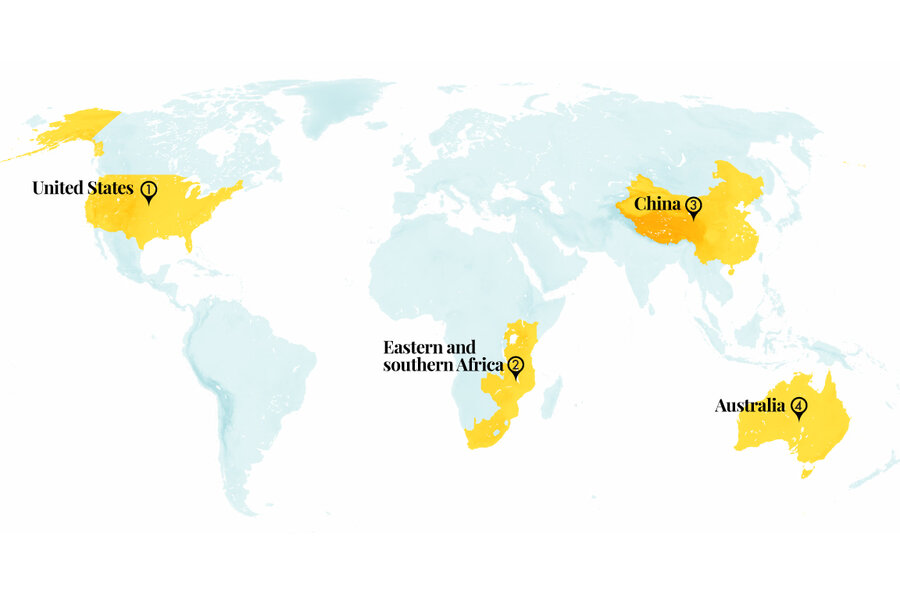Uplifting news around the globe: Eco-friendly batteries and greener cement
Loading...
A startup working on decarbonizing cement poured its first commercial concrete
Accounting for 8% of the world’s carbon emissions, traditional cement production heats limestone to over 2,500 degrees Fahrenheit to produce lime. But high-temperature kilns rely on fossil fuels, and limestone itself releases carbon dioxide in the process.
Instead, startup Sublime’s electrolyzer uses electrochemical reactions to dissolve materials at room temperature – eliminating both major sources of CO2 that result from making 4 billion metric tons of the world’s most-produced material each year. The technology can also use substances other than limestone. The company says the new cement meets international standards and has performed similarly to ordinary portland cement. It reaches similar flow rates, hardens in the same way, and is just as strong and durable.
Why We Wrote This
A story focused onIn our progress roundup, scientists and advocates tease out solutions to the problems of carbon emissions from concrete, higher salinity in farmlands, and the need for more battery safety.
Sublime’s formula was recently used in a nonstructural part of the ground floor in a building in Boston. Other startups are also tackling cement; Brimstone Energy makes portland cement from carbon-free calcium silicate. Sublime, founded by electric chemists Leah Ellis and Yet-Ming Chiang, hopes to scale up to a commercial facility capable of producing 1 million tons of cement yearly by 2028.
Source: Fast Company
In eastern and southern Africa, roadside clinics are helping truckers access health care
Working long hours and confined to their vehicles, many truckers struggle to focus on their own well-being. Half of Kenya’s deaths and hospitalizations each year are attributed to so-called noncommunicable lifestyle diseases. But with a network of clinics in eastern and southern Africa, the nonprofit Northstar Alliance brings services to workers on the move and residents in border town and port communities.
The clinics, housed in shipping containers, adjust operating hours to accommodate the schedules of mobile workers. Outreach programs target groups that face barriers to traditional health services, such as sex workers and street vendors. Staff members can access patient records from any of the clinics, allowing them to track patient progress. In 2006, the clinics first addressed the high mortality rates of truckers during the AIDS epidemic. In 2022, the clinics provided services to 180,000 people, nearly a third of whom were truck drivers.
Source: The Guardian
People with impaired vision are leading the charge to make smartphones more accessible
Most smartphones come with text-to-speech software that reads words aloud. But functionality is limited to apps that are compatible, and many developers do not account for accessibility features in their code. In China, the Shenzhen-based nonprofit Accessibility Research Association works with internet and software companies to develop accessible technology.
Founded in 2005, the association initially offered vision-impaired people courses on how to use computers and smartphones, but quickly realized that many products didn’t meet accessibility needs. The group put together a team of partially sighted engineers to identify problems and suggest solutions to developers. One engineer, Fan Jiancai, started a forum that allows partially sighted people to talk about everything from music to their experiences with different software.
In 2020, China’s government and the China Disabled Persons’ Federation released official guidelines to promote information accessibility. As of 2022, a total of 375 websites and apps had been updated with accessibility features.
Source: Sixth Tone
Chemists used a metal and its rust to overcome a short-circuiting problem in their “water battery”
Also known as aqueous metal-ion batteries, the technology is being explored as a safer alternative to industry-standard lithium-ion batteries. While found in everything from phones to electric vehicles, lithium batteries carry a risk of fire and explosion, making them less suitable for large-scale energy storage. Aqueous metal-ion batteries replace the volatile components with water, enabling electric current flow and eliminating the risk of fire.
The researchers have struggled with dendrites – spiky metallic formations that can cause a battery to short-circuit. In a recent study led by Australia's Royal Melbourne Institute of Technology, engineers coated battery parts with bismuth and rust, which protected against dendrites. While lithium-ion batteries can be difficult to recycle, researchers said that water batteries can be easily disassembled and reused. They also noted that water batteries have shown stable renewable energy storage and last longer than their lithium counterparts.
The team is making strides toward increasing the batteries’ energy density, or the amount of energy that can be stored in a given space. Co-author Tianyi Ma said that future water batteries would be made from magnesium and that they could replace lithium-ion batteries in the next decade.
Sources: RMIT, Science, Advanced Materials
Nonprofits are helping farmers adapt to higher soil salinity
Scientists estimated a decade ago that at least 20% of cultivated land is affected by high salinity. Soil salinization – which can occur naturally but in many parts of the world has been driven by climate change and poor water management – can damage plants and reduce yields.
On the Dutch island of Terschelling, De Zilte Smaak (“The Salty Taste”) grows foodstuffs such as samphire, a salt-loving plant with slim stalks. Samphire and leafier greens such as sea aster are harvested from the test field and served in restaurants across Terschelling. Another group, Saline Agriculture for Adaptation, has been developing salt-resistant crops in the European Union, Morocco, and Egypt. The Netherlands-based Salt Doctors social enterprise has disseminated knowledge about how to grow crops in salty conditions from Vietnam to Cuba.
In China, scientists recently reported an approach focused on soil. They laid crop stalks flat, buried 12 to 16 inches deep to prevent salt from rising to the surface, and covered the ground with plastic to retain moisture. Crop yields increased by 30.5% and soil salinity decreased by 36%.
“As humans, we tend to always adapt the environment to us,” said Arjan Berkhuysen of De Zilte Smaak. “Here, [we] try to adapt ourselves to the environment.”
Sources: Reasons to be Cheerful, South China Morning Post










